Abstract
To fully understand the role of genetics and environment (biotic, abiotic and sociocultural) in the prostate cancer disparity experienced by African-American men, this paper examined the rates of prostate cancer among African-American men and one of their ancestral populations in west Africa. Data sources were from the World Health Organization (WHO) and reported hospital records in the literature. Based on the WHO's worldwide cancer data, west African men have much lower prostate cancer incidence and mortality compared to African-American men. For example, compared to Nigerian men, African-American men are >10 times likely to develop prostate cancer and 3.5 times likely to die from the disease. However, contrary to the global ranking by WHO, there is documented evidence in the literature indicating that prostate cancer in at least one west African country is similar to rates found in the United States and in Caribbean Islands. To better address prostate cancer disparity, future studies should study populations and subgroups from central and west Africa, the original source population for African Americans.
Full text
PDF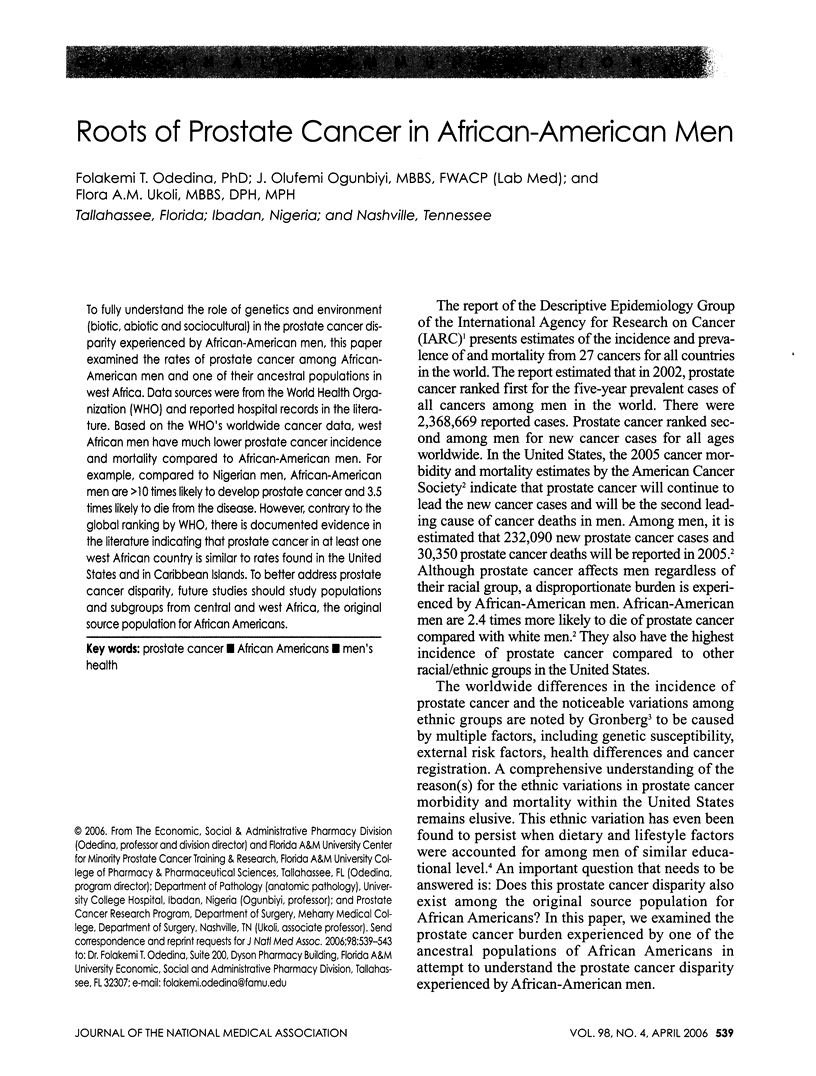
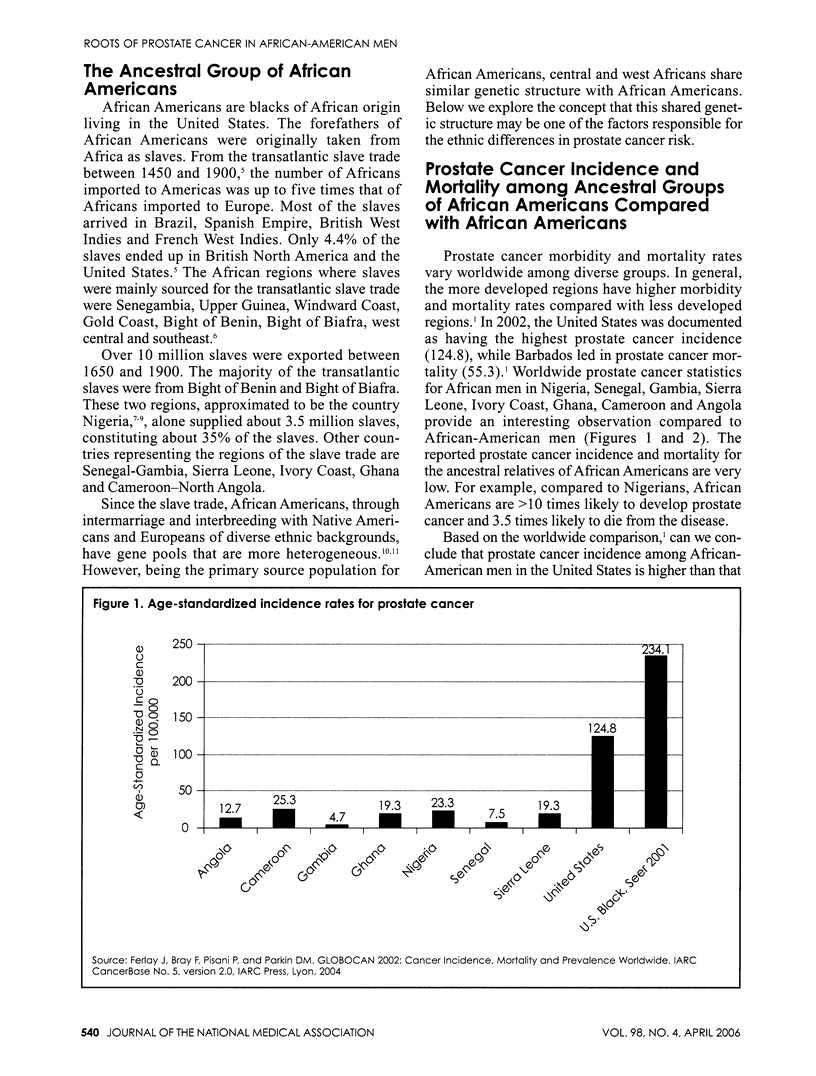
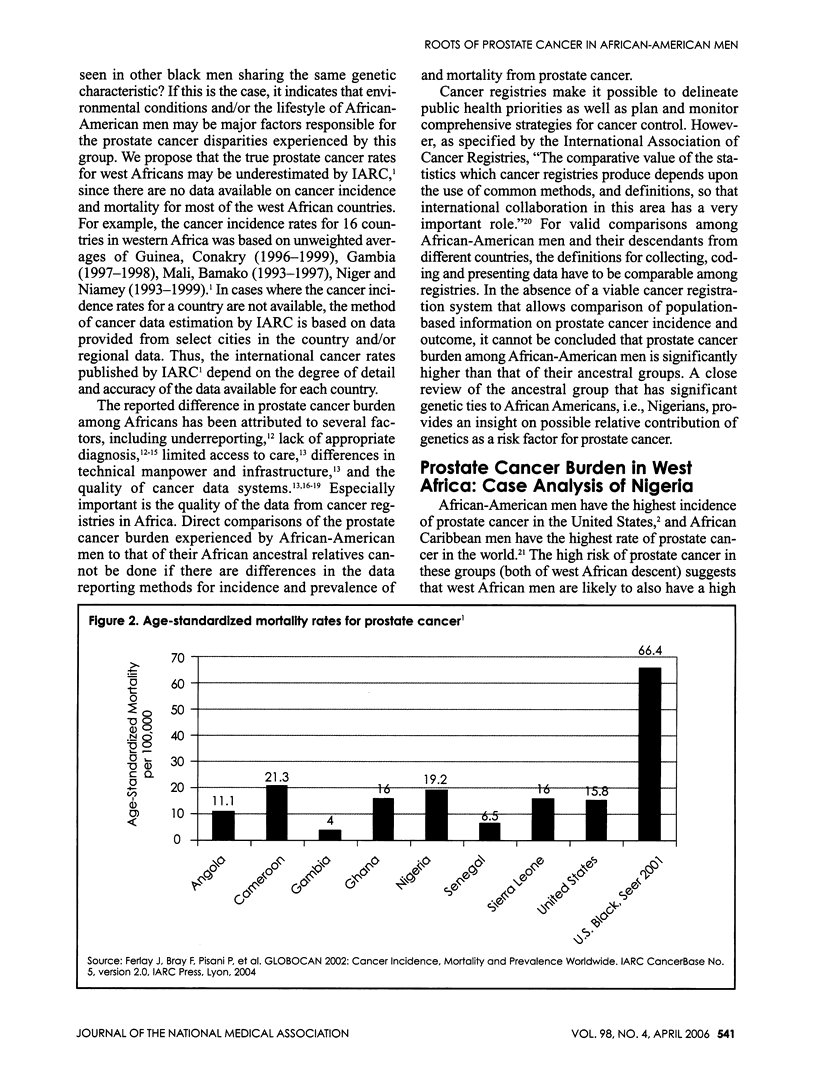
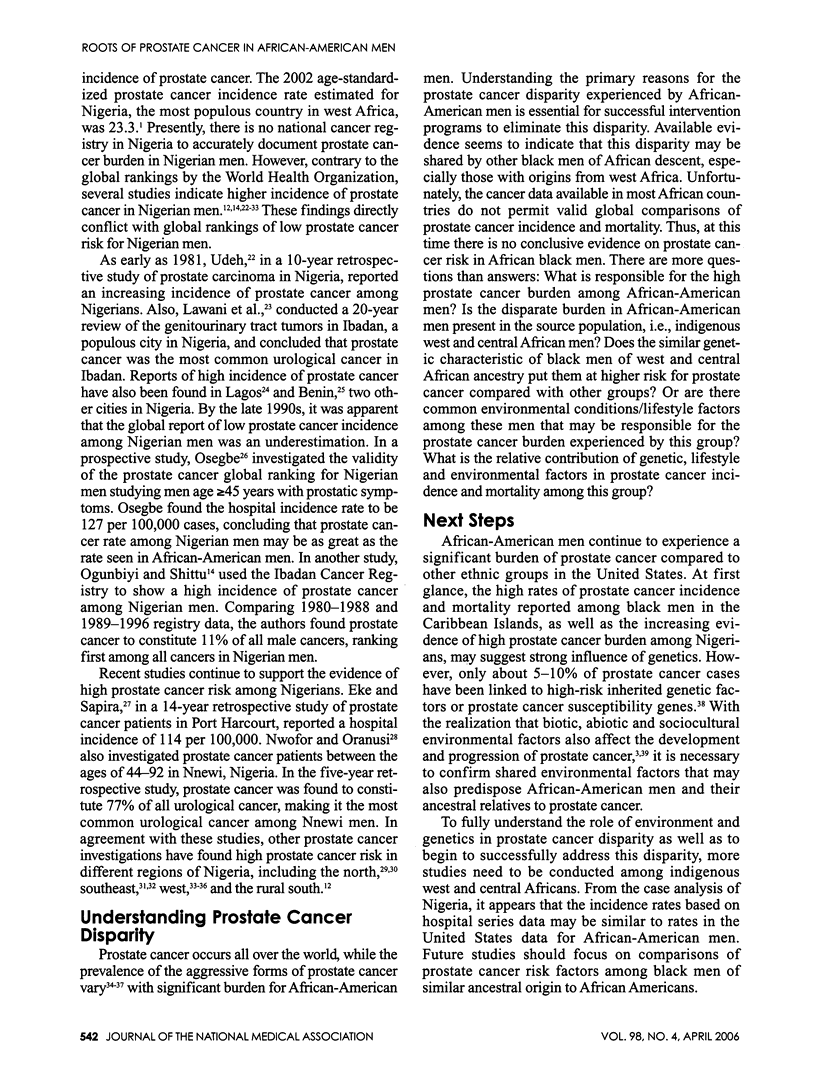
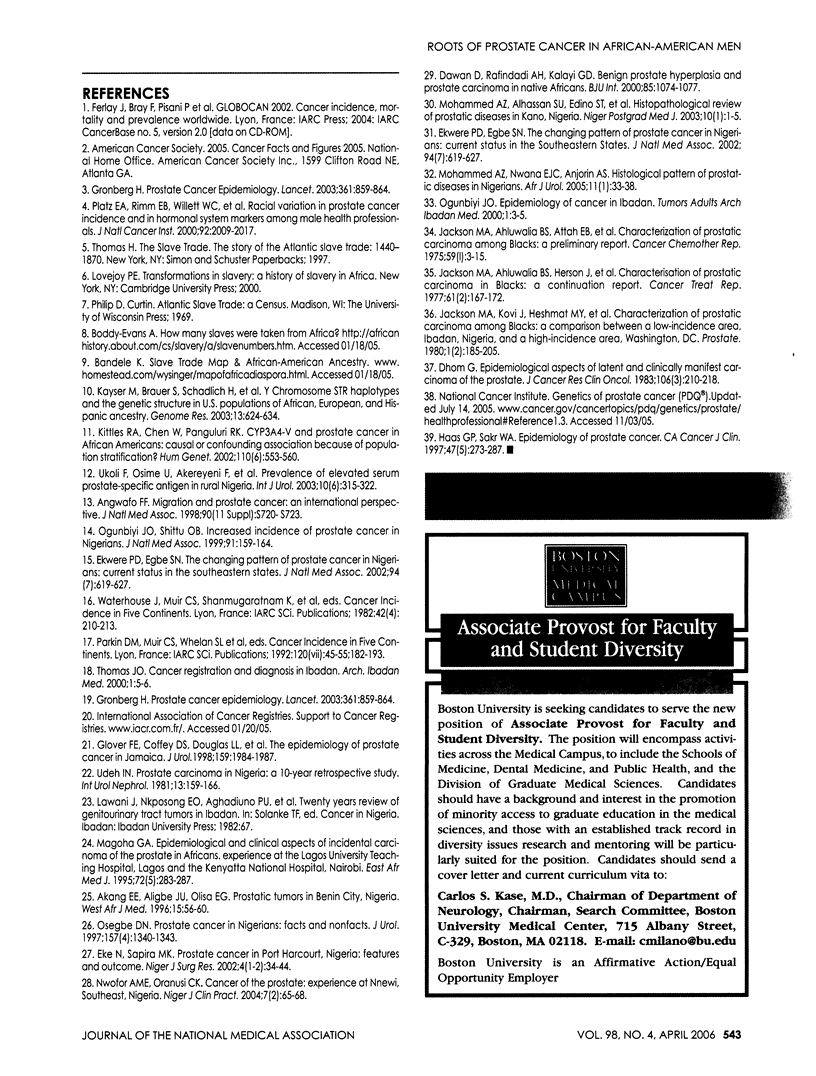
Selected References
These references are in PubMed. This may not be the complete list of references from this article.
- Akang E. E., Aligbe J. U., Olisa E. G. Prostatic tumours in Benin City, Nigeria. West Afr J Med. 1996 Jan-Mar;15(1):56–60. [PubMed] [Google Scholar]
- Angwafo F. F. Migration and prostate cancer: an international perspective. J Natl Med Assoc. 1998 Nov;90(11 Suppl):S720–S723. [PMC free article] [PubMed] [Google Scholar]
- Dawam D., Rafindadi A. H., Kalayi G. D. Benign prostatic hyperplasia and prostate carcinoma in native Africans. BJU Int. 2000 Jun;85(9):1074–1077. doi: 10.1046/j.1464-410x.2000.00677.x. [DOI] [PubMed] [Google Scholar]
- Dhom G. Epidemiologic aspects of latent and clinically manifest carcinoma of the prostate. J Cancer Res Clin Oncol. 1983;106(3):210–218. doi: 10.1007/BF00402610. [DOI] [PMC free article] [PubMed] [Google Scholar]
- Glover F. E., Jr, Coffey D. S., Douglas L. L., Cadogan M., Russell H., Tulloch T., Baker T. D., Wan R. L., Walsh P. C. The epidemiology of prostate cancer in Jamaica. J Urol. 1998 Jun;159(6):1984–1987. doi: 10.1016/S0022-5347(01)63220-8. [DOI] [PubMed] [Google Scholar]
- Grönberg Henrik. Prostate cancer epidemiology. Lancet. 2003 Mar 8;361(9360):859–864. doi: 10.1016/S0140-6736(03)12713-4. [DOI] [PubMed] [Google Scholar]
- Grönberg Henrik. Prostate cancer epidemiology. Lancet. 2003 Mar 8;361(9360):859–864. doi: 10.1016/S0140-6736(03)12713-4. [DOI] [PubMed] [Google Scholar]
- Haas G. P., Sakr W. A. Epidemiology of prostate cancer. CA Cancer J Clin. 1997 Sep-Oct;47(5):273–287. doi: 10.3322/canjclin.47.5.273. [DOI] [PubMed] [Google Scholar]
- Jackson M. A., Ahluwalia B. S., Herson J., Heshmat M. Y., Jackson A. G., Jones G. W., Kapoor S. K., Kennedy J., Kovi J., Lucas A. O. Characterization of prostatic carcinoma among blacks: a continuation report. Cancer Treat Rep. 1977 Mar-Apr;61(2):167–172. [PubMed] [Google Scholar]
- Jackson M. A., Kovi J., Heshmat M. Y., Ogunmuyiwa T. A., Jones G. W., Williams A. O., Christian E. C., Nkposong E. O., Rao M. S., Jackson A. G. Characterization of prostatic carcinoma among blacks: a comparison between a low-incidence area, Ibadan, Nigeria, and a high-incidence area, Washington, DC. Prostate. 1980;1(2):185–205. doi: 10.1002/pros.2990010205. [DOI] [PubMed] [Google Scholar]
- Kayser Manfred, Brauer Silke, Schädlich Hiltrud, Prinz Mechthild, Batzer Mark A., Zimmerman Peter A., Boatin B. A., Stoneking Mark. Y chromosome STR haplotypes and the genetic structure of U.S. populations of African, European, and Hispanic ancestry. Genome Res. 2003 Apr;13(4):624–634. doi: 10.1101/gr.463003. [DOI] [PMC free article] [PubMed] [Google Scholar]
- Kittles Rick A., Chen Weidong, Panguluri Ramesh K., Ahaghotu Chiledum, Jackson Aaron, Adebamowo Clement A., Griffin Robin, Williams Tyisha, Ukoli Flora, Adams-Campbell Lucile. CYP3A4-V and prostate cancer in African Americans: causal or confounding association because of population stratification? Hum Genet. 2002 May 7;110(6):553–560. doi: 10.1007/s00439-002-0731-5. [DOI] [PubMed] [Google Scholar]
- Magoha G. A. Epidemiological and clinical aspects of incidental carcinoma of the prostate in Africans: experience at the Lagos University Teaching Hospital, Lagos and the Kenyatta National Hospital, Nairobi. East Afr Med J. 1995 May;72(5):283–287. [PubMed] [Google Scholar]
- Mohammed A. Z., Alhassan S. U., Edino S. T., Ochicha O. Histopathological review of prostatic diseases in Kano, Nigeria. Niger Postgrad Med J. 2003 Mar;10(1):1–5. [PubMed] [Google Scholar]
- Ogunbiyi J. O., Shittu O. B. Increased incidence of prostate cancer in Nigerians. J Natl Med Assoc. 1999 Mar;91(3):159–164. [PMC free article] [PubMed] [Google Scholar]
- Osegbe D. N. Prostate cancer in Nigerians: facts and nonfacts. J Urol. 1997 Apr;157(4):1340–1343. [PubMed] [Google Scholar]
- Platz E. A., Rimm E. B., Willett W. C., Kantoff P. W., Giovannucci E. Racial variation in prostate cancer incidence and in hormonal system markers among male health professionals. J Natl Cancer Inst. 2000 Dec 20;92(24):2009–2017. doi: 10.1093/jnci/92.24.2009. [DOI] [PubMed] [Google Scholar]
- Udeh F. N. Prostatic carcinoma in Nigeria: a 10-year retrospective study. Int Urol Nephrol. 1981;13(2):159–166. doi: 10.1007/BF02082060. [DOI] [PubMed] [Google Scholar]
- Ukoli Flora, Osime Usifo, Akereyeni Folasade, Okunzuwa Osazuwa, Kittles Rick, Adams-Campbell Lucile. Prevalence of elevated serum prostate-specific antigen in rural Nigeria. Int J Urol. 2003 Jun;10(6):315–322. doi: 10.1046/j.1442-2042.2003.00633.x. [DOI] [PubMed] [Google Scholar]


